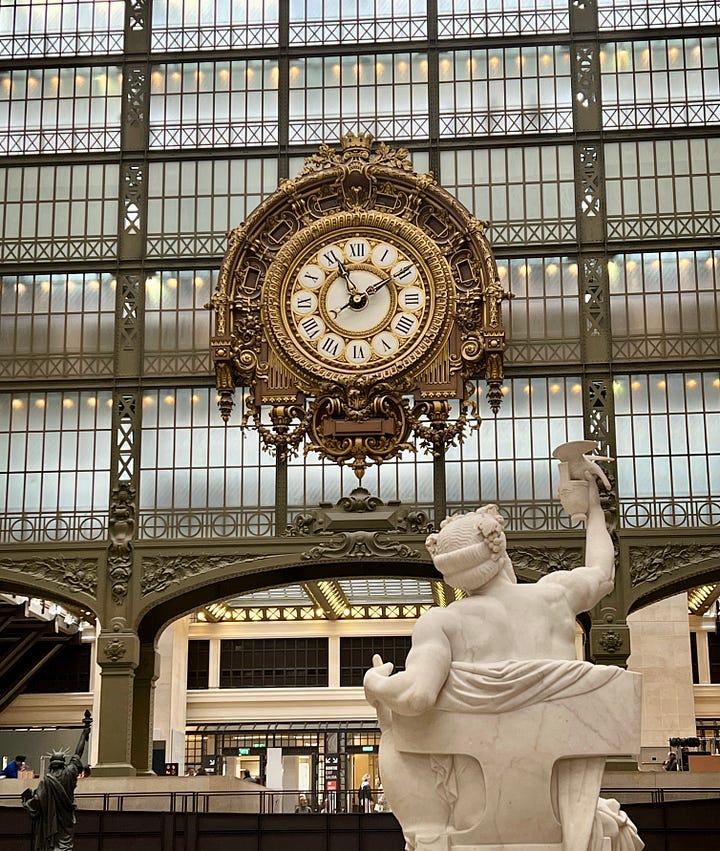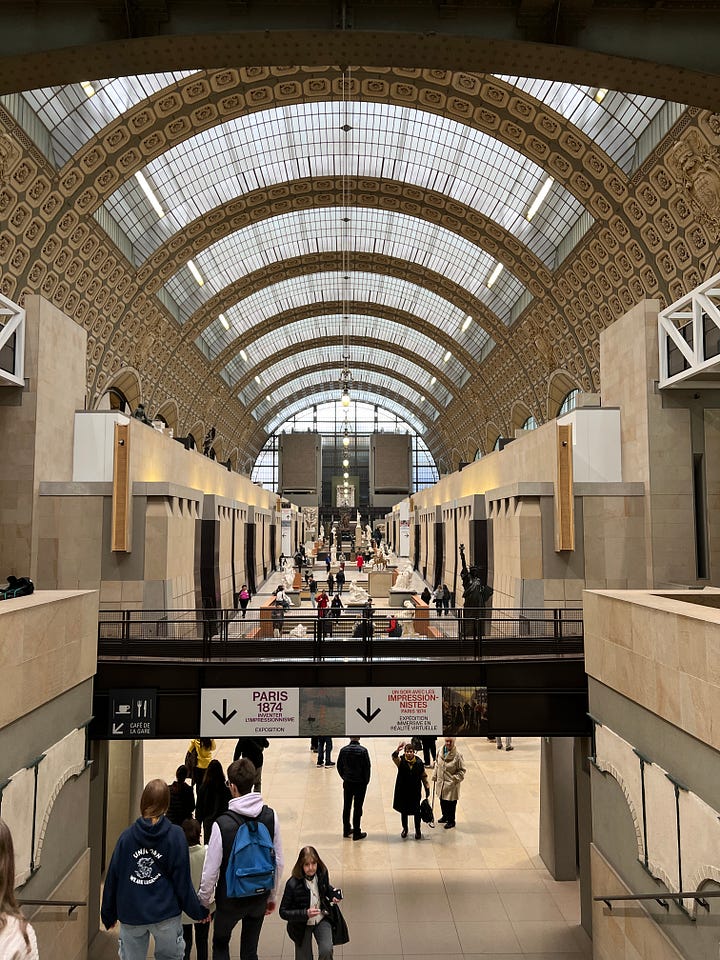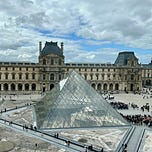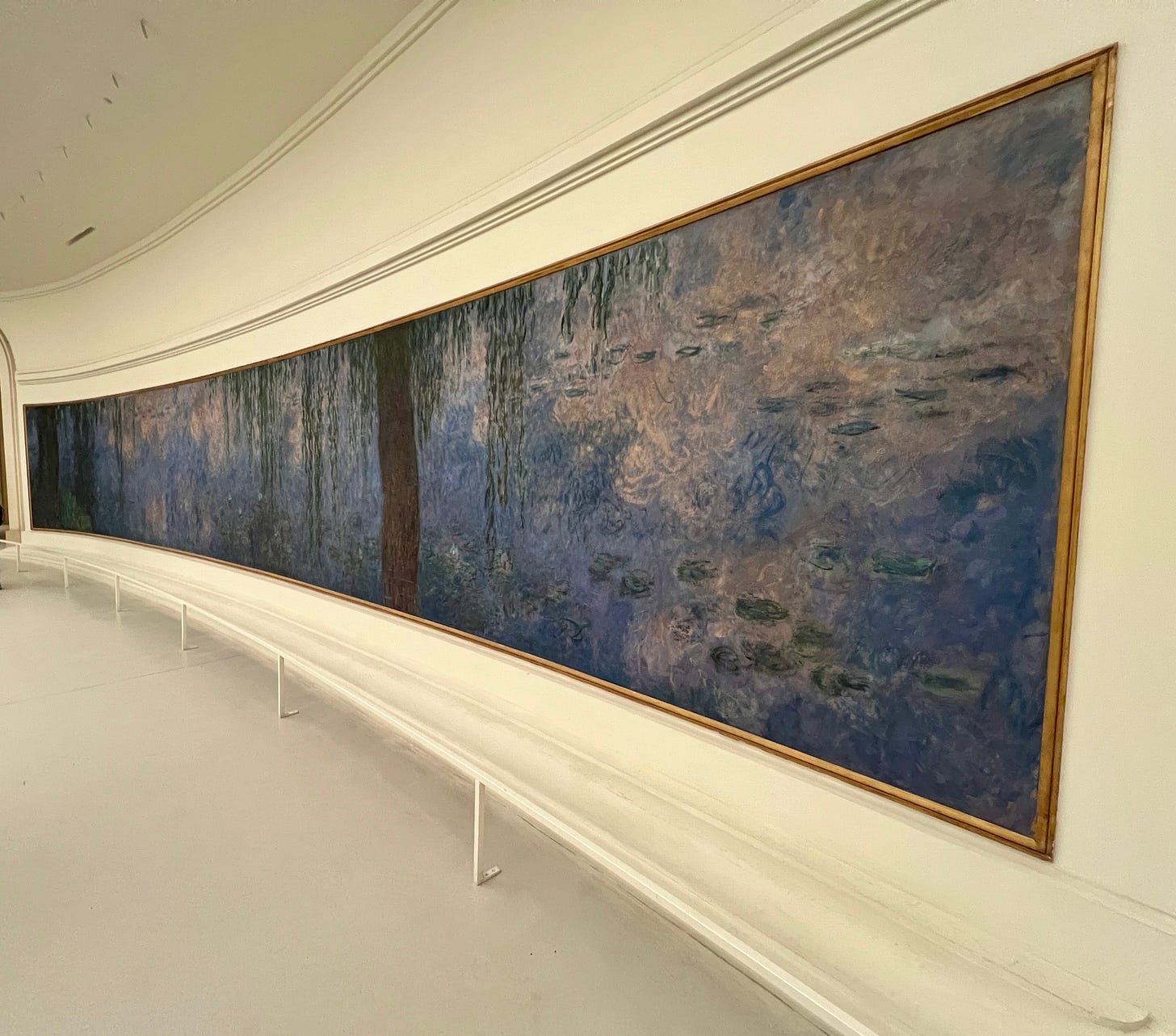Both: Hey everyone!
Jen: It's Jen and Greg with an update on our travels.
Greg: So the last update, we talked about the tours. But this time we're going to talk about the museums. I enjoy museums; I always have. And I've always wanted to go to the Louvre. It is one of the most famous, if not the most famous museum in the world.
So when we travel to other places like Manhattan, we spent a few hours at the Natural History Museum, and I said, “Oh, it's not enough.” Then we went to the Art Institute in Chicago once and we were there for almost six hours and when we left, I said, “Oh, it's not enough.” So for the Louvre, we planned on two days and I can tell you, I enjoyed every minute of it.
And it kind of really wasn't enough… (laughs)
Jen: (laughing)
Greg: Fun fact, the Louvre has over 600,000 items in their collection, not just paintings. Most of that collection's in storage, but they normally have approximately 35,000 items on display at any time.
Jen: So our guide told us that if you looked at each painting for one minute for 24 hours a day, it would take you up to seven days to go through all of the paintings that are on display. That's nuts!
Greg: It's…fantastic.
Jen: (laughing) So one thing I will say about the Louvre is that it was actually uncomfortably hot in several parts. I don't know if they had the heater on because it was a little cooler outside or what, but...
Greg: Yeah, definitely layers in the Louvre. Don't wear long sleeves because some parts, man, you will sweat.
The first thing that we did was an official Louvre tour. It's a guided tour, called “Welcome to the Louvre”, where they take you through some of the most popular pieces. And we scheduled it so that we would be done with the tour around the same time that the extended hours were happening.
Jen: Yeah, and so the extended hours, on Friday nights, they are open 'til 9 or 9:30.
So it was kind of fun to walk through. And I told Greg at one point, I was like, “it's almost like Night at the Museum. I keep waiting on stuff to come alive like the movie.” But sadly it did not happen that way. Some of the ones we saw, The Venus de Milo, which is actually called The Woman with No Arms.
Greg: And it's interesting only because it's not a masterpiece.
And people thought that it was because after Napoleon lost, France was approached to say, “Give us back all the stuff Napoleon took.”
Jen: Right.
Greg: And so a lot of the Roman statuary had to be given back, but she was not taken in conquest. She was legitimately found by an archaeologist and given to the Louvre. So when they gave back all of the other statues, it left Woman with No Arms alone in a big area and people thought, “Oh, it must be because it's a masterpiece and they're giving people plenty of space.”
And so that's why it has the reputation it has. It's actually not even that impressive of a statue because it's not all one piece from marble. It's piecemeal, kind of like a mannequin.
And to talk about how installation of an exhibit matters. Because Venus de Milo was in a room by itself, people immediately thought this has to be a masterpiece, even though it's not. On the other hand, Winged Victory of Samothrace IS a masterpiece. It's one complete carving - from marble - and there are techniques used which people today are just absolutely stunned that's someone achieved by hand. For example, a belly button that you clearly see has been carved out behind a, like, sheer mosquito net type, uh, material cutting across her abdomen as the wind blows it back.
It's, it's an impressive piece, but it's in the middle of a stairs area. And so nobody really understands how great that piece is.
Jen: Yeah. If we wouldn't have been on that tour, I totally would have walked by that 'cause it was kind of just like, “Oh, let's put this here 'cause we need something to put in this staircase,” but...
Greg: Yeah, exactly.
Jen: It was really huge. And really, that was probably my favorite thing of that day, statue-wise anyway.
Greg: Yeah. And I think it's just more of the evidence of how many people visit the Louvre and have really no idea. And they just...they look, like, the Mona Lisa. It's, it's massively packed in that room and nobody notices anything else in there.
And the Mona Lisa itself has some noteworthy aspects because of the techniques that DaVinci used, but by and large, it's not as noteworthy as it has become. It's only because it was stolen.
Jen: Right. Wasn't it stolen by Italian handy? Not handyman, but they were renovating part of it. And he said that he didn't want any of the Italian paintings in France.
He wanted a different painting, but it was too big for him to steal by himself. So he's like, “well, I'll just take her.” And it went missing for a long time. And it was the subject of news articles and it was this big scandal. So now, that's really why she's famous. She's on this one wall, guarded. There's plexiglass, there's all this stuff. And about 300 people trying to take a picture.
Greg: Mm hmm. And every one of those 300 missing a much more impactful painting directly across from the Mona Lisa called The Wedding Feast of Cana. It's the largest painting in the Louvre. It's like 30 feet wide by 20 feet tall.
Jen: Yeah, it takes up the entire wall, like floor to ceiling for sure. And I liked it.
I didn't know anything about it before, but I think the bigger paintings are neat because there's always like these little Easter eggs that they've placed in the paintings. Like this one, I think had a dog stealing an apple or something off the table. But it's all these little things that they point out and you don't really see that until somebody says, “Oh, look at that!”
Greg: Yeah. And another example of a big painting that people were missing is when you walk out of the room that has the Mona Lisa, you go around a corner and, like, you basically are next to - what I think might be the best painting in the Louvre - The Coronation of Napoleon. It's another just terrifically huge painting.
It's so detailed and it's so well painted and it has its own mysteries and Easter eggs, like you said. And, like, there was our group and, like, another two people looking at this painting while everyone else was staring at the back of someone else's head trying to get at the Mona Lisa.
Jen: (laughing) Yeah. I think that one, just the colors in that one was so pretty.
Greg: Mm hmm. We also got to see numerous pieces from, you know, ancient Greece and ancient Rome and, I mean, just all over. They just have so much at the Louvre. And that's why we chose to do the Louvre for two days instead of just one. And the second day we started with the other guided tour that they do. It's called, “Another Louvre.”
Jen: Which brought us to more of the less popular, but equally as awesome, works of art that we didn't see the day before.
Greg: Yes. And the number one thing that we wanted to see and was on that tour was the Code of Hammurabi, which I'm sure some of you might be familiar. But if you're not, it's this stone, kind of like an obelisk, and it is inscribed, very small, cuneiform text describing the entire code of law for all the lands that were ruled by Hammurabi, who was a Babylonian king. It goes back to 1700 BC. It's so massively significant and almost no one goes by it in the Louvre.
Jen: Yeah, I mean, we didn't even know it was there, honestly, until we saw online and then we got super excited, like, “Oh, that's in the Louvre! Great, we're gonna see it today!”
Greg: Yeah.
Jen: There's also all of these ancient Greek and Roman statues, and it's just really kind of awe-inspiring to be in there with all of these beautiful works of art.
Greg: Yeah. So, other than those statues, the other big piece that we had to go see on our own after the Day 2 tour was a painting right up my alley called Raft of Medusa.
Jen: High drama. That's why it's right up his alley.
Greg: All the figures have faces of anguish or joy. Their bodies are in poses that are action-oriented, grabbing something, pushing someone away.
It's... it's great art.
Jen: Yeah.
Greg: It really is.
Jen: It was a large painting, too.
Greg: Not compared to The Coronation of Napoleon or The Wedding Feast of Cana!
Jen: That's true.
Greg: But yeah, I mean, we should move on because we're talking about the Louvre and we could talk about it all day.
Jen: Yeah, we also went to the Musée d'Orsay and the building itself was almost a piece of art.


It was really cool architecturally. It used to be a train station. And the audio guide itself, you could hold the audio guide screen up and look around the building as it is now and it would show you what it looked like back when it was a train station. So that was a pretty neat little feature in that audio guide.
Greg: Yeah. And besides the marvelous architecture of the building, the exhibit on display at that time was called, 1874 in Paris. And I gotta say, I thoroughly enjoyed the exhibit. I think I have more of an appreciation for Impressionism now as a result. If you're unfamiliar, the exhibit is specifically showing the works of art of several prominent painters who were in Paris in 1874 of their own accord.
They just all ended up there and chose to do a gallery and put on a show with some of their work. And it's not just the typical loosely defined tappings of brushes on the painting with pastel colors. There were numerous paintings, richly colored, some of them very detailed. But I, I enjoyed it.
Jen: So we also went to L'Orangerie, which is one of the most famous art installations in the world of Claude Monet's Water Lilies.
Greg: So I think what was significant about L'Orangerie and - I guess frustrating in a way - is all the people that ignored it. Monet himself helped design the installation, and the idea he had was, he wanted it to be white. He wanted all the light to be natural, so there's no artificial light in the installation, and you're supposed to walk in one side.
And you're supposed to view what are seasonal differences in each of the pieces that make up Water Lilies. You also have a difference in time of day. His thought was you walk a specific path and get an idea of his favorite place in kind of a 360 view around you, but also seasonally and, like, time of day elapsing.
But people were going in through the exit. People were just standing around and you're supposed to be quiet. He specifically wanted it to be an area of silence so people could just bask and appreciate his place of peace, which is why he painted it. And, I mean, you just had people who didn't care, being loud, had to be told several times, “Get off of that. That's not for sitting. Don't touch that, please.”
Jen: But...it was very beautiful.
Greg: So it took three updates, but that's our time in Paris.
Jen: C'est fini!
Greg: After Paris, we spent a brief couple of days in London. So that will be the next update.
Jen: Even though Paris was great, we spent about eight or nine days there, and we were definitely ready to go.
Greg: Yeah, it was kind of getting to be a bit much in Paris.
Jen: Yeah, I was really looking forward to London, so.
Greg: Why were you looking forward to London?
Jen: Shamefully, I like the royal family and all of its drama and all of the stuff that goes along with...England.
Greg: What's “all of the stuff”?
Jen: Ohhhh, you know…English stuff.
Tea.
Greg: Okay.
Jen: Even though I don't like tea, I wanted to do an afternoon tea. So, yeah, the buses, the tube, the... I don't know, all the stuff.
Greg: Mm hmm. Yeah...
Jen: But we're not going to talk about that now because it's not a London update, it's a Paris update. (laughing)
Greg: Yes, that's true. So, thanks for checking in!
Jen: And we'll see you at the next stop!
















